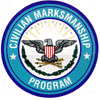
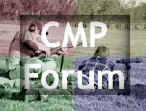
| We want your feedback! Please let us know what you think about TFS. Do you have an interesting story or article that you would like to share? If so, please let us know!
|
Reader Comments:
Great articles. Great to identify those who are participating as well as those who are working behind the scenes to make the whole of the National Matches run so well.
David D.
Boxford, MA
This is a special note just for my friends at the CMP, I want to thank you all for your hard work and attention to details, it's a great program!
"You help our shooting dreams come true!"
Best Regards,
Tony M.
CMP,
Your review of the CMP EIC brought back good memories. My son and I usually participate in the rifle event. This was the first time we participated in the pistol event. Our experience was positive and we have decided to come back and do it again next year!
DAVE J. H.
I don't think that I have taken the time lately to thank you and the CMP for your faithfulness in keeping me updated on all of the CMP news. I thank you and your staff very much for the fine job you are all doing.
Many thanks, and keep up the great work!
Pete
Your article titled "Rifle Cleaning and Maintenance" was so timely. I am a novice rifle shooter, and the information is just what I needed. The owner's manual that came with my rifle is far too sketchy and assumes the new owner is experienced. This is concise yet detailed enough to make me comfortable cleaning my firearm.
Regards,
Jane W.
Cleaning a rifle or handgun is not a lot of fun. The article on cleaning the rifle met the K.I.S.S. principle that I can relate to and understand. To the point.
Arthur S.
Thank you for this excellent e-newsletter. The links and information are great.
Sincerely,
John B.
I greatly enjoy the USAMU shooting tips in the newsletter and also being able to find them on-line.
Regards, Ray in FLA
EXCELLENT BRIEF UNDERSTANDABLE ARTICLE ON SITTING RAPID POSITION, BEING CLOSE TO 60 THIS IS MY WORST POSITION AND ANY HELP I CAN GET IS GREATLY APPRECIATED!
GOOD ARTICLE; MARTY
SFC Singley:
It has been a while, but I sent CMP a request for a TFS article on possible means by which us "centrally endowed" (read that as 'fat') shooters might work ourselves into a useable sitting position. Spring is coming and I will be trying to get ready for matches. Your article has been copied and I will read it and work on trying the options you have provided. Thanks very much for your individual military service to our Nation and for your personal efforts to help other shooters improve our skills.
Melvin C.
Really enjoyed the M1 for Vets article. Its really good to read something that was done for
wounded vets. The match must have been a real wingding. Too cold for me. There is alot of
history 1903 Springfield and the M1 . I had to sleep with my o3 for baning the butt on the
deck in boot camp. Anyway thanks again for the story.
Jim N., Ok
I enjoy the TFS. In fact, occasionally I like to print some of the articles to be able to review them in the future.
James L. M.
Whenever we come back in from the field it’s always a good day when “The First Shot” is in. I drill the guys in the fundamentals – many of which I learned and fine tuned at CMP matches – and it comes back in spades out here when it really counts!
Dean H.
LTC - US Army
Security Advisor
Kabul/Afghanistan
|
|
|
 |
National Matches Team Matches
By Gary Anderson, DCM
|
|
Team Matches are a big part of the National Trophy Rifle Matches program. Many shooters and coaches regard the National Trophy Team Match, in particular, as the most important trophy and team championship in American marksmanship. The National Trophy, which was commissioned by the U. S. Congress in 1903, goes to the overall winning team in the National Trophy Team Match, but the Soldier of Marathon Trophy for the top Civilian team, the Hilton Trophy for the top Reserve Component Team and the Minuteman Trophy for the top Junior team, along with the Infantry, Hearst and Whistler Boy Trophies represent especially prestigious team titles that service rifle teams all over the country put great effort into trying to win.
Three days of the National Trophy Rifle Matches schedule are dedicated to team competitions. After three days of individual competition in the M16EIC, President’s and National Trophy Individual Matches are over, the first team day is for two-person team matches. The Hearst Doubles Match is for open teams where shooters can choose any partner they wish. Hearst Doubles team members may coach each other, but they cannot have a separate coach. The Whistler Boy Match is for junior teams that represent clubs. Whistler teams can have coaches with them on the line.
|
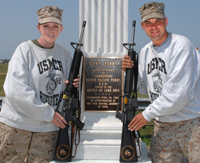
|
|
GySgt Julia Watson and Sgt Eric Swearingen pose with their service rifles at Camp Perry’s Commodore Oliver Perry monument to celebrate their victory in the Hearst Doubles Team Match.
|
242 teams with nearly 500 individual competitors completed the 2007 Hearst Doubles Match. Each team member fired 10 shots standing at 200 yards, 10 shots rapid fire prone at 300 yards and 10 shots slow-fire prone at 600 yards. Team members must pair fire the slow-fire stages.
Hearst Match results featured a close contest between two Marine Corps Reservists and two Army Marksmanship Unit shooters. The Army’s SFC Grant Singley and SGT Brandon Green combined 295-10X and 294-12X scores to total 589-22X. Marine Reservists GySgt Julia Watson and Sgt Eric Swearingen combined 297-14X and 293-3X scores to total 590-17X and gain a one-point victory. Watson’s 297-14X total was the top individual score of the day.
|
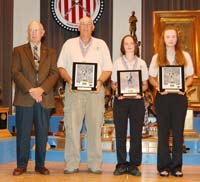
|
|
The Washington State R&PA “Bad Applettes” team of Kelsi Unangst and Jennifer Nyberg that was coached by Jonathon Shew won the Whistler Boy Junior Highpower Team Match.
|
The Whistler Boy Junior Team Match was also highlighted by close competition where only two points separated the top three teams. Ryan Castonguay and Amanda Elsenboss of the Connecticut Palmer team fired 485-15X and 484-12X to total 969-27X. Elsenboss teamed with Julie Coggshall to win this match in 2006. Two teams, the California Grizzlies Gold and Washington State Rifle and Pistol Associations “Bad Applettes” both posted 971 totals. Kathrn Bugg fired 486-10X and Jason Case totaled 485-13X for the California team. Kelsi Unangst shot 486-13X and Jennifer Nyberg had 485-14X for the Washington team. The Washington team, which was coached by Jonothan Shew, had 27Xs to 23Xs for the California team to win the trophy. Shew is the CMP State Junior Director in Oregon. Jim O’Connell coached the California team, while Brad Palmer coached the Connecticut team. For the second consecutive year an all-girls team won the Whistler Boy Trophy.
The National Trophy Team Match is often called the “Big Team Match” by experienced service rifle shooters. Teams go on the line with six members, a coach and a team captain. One of the six firing members must be a “new shooter” who has not previously fired in this event. Developing a new shooter who can perform well under so much pressure is often a key to winning this match.
|
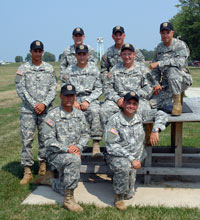
|
|
The U. S. Army Marksmanship Unit “Praslick” team used a strong performance at 600 yards to win the National Trophy in 2007. SSG Emil Praslick (right front) was the team coach. SGT Walter Craig was the team captain. Team members were SFT Grant Singley, SGT Brandon Green, SFC Lance Hopper, SFC Kyle Ward, SFC Lance Dement and SPC Matthew Sigrist (new shooter).
|
After winning both the six and ten-person team matches at the Interservice Matches immediately before the National Trophy Rifle Matches, the U. S. Army Marksmanship Unit team was the favorite to win this year. It was not to be an easy victory, however. In past years it was the Marines that challenged the Army team; indeed, in 2006, the Marines won big while setting a new National Matches record. This year the Marines started strong again this year. Their 579 six-person standing total, 597 sitting rapid fire and 591 prone rapid fire gave USMC Scarlet the lead after each of the first three stages. Going into the 600 yard stage, the Marines held a scant four-point lead over the Army and Army Reserves teams. But at 600 yards where the wind doping and coaching skills of team coach SSG Emil Praslick began to make a real difference, the USAMU team fired a combined 1174 600 yard total to gain a 13 point lead over USAR Gold that finished second. At the same time, the Marine team that was in the lead had a cross-fire and no single 600 yard score over 195 to drop all the way to sixth place.
One of the major trophies awarded during the matches is the Pershing Trophy that is awarded to the competitor who fires the highest individual score in the National Trophy Team Match. SFC Grant Singley, who led the Army Marksmanship Unit team, topped the Pershing Trophy list this year with a 496-22X total.
|
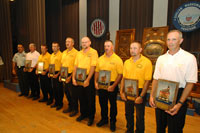
|
|
The Pennsylvania Rifle & Pistol Association Team won both the Soldier of Marathon Trophy for being the high Civilian team in the National Trophy Team Match and the Leatherneck Trophy for being the high Civilian team in the Infantry Team Match. Team captain was David Little, the team coach was William Gelet. Team members were Thomas Rider, Mark Heff, Bill Bowers, James Potter, Michael LaRuffa and Ron Smith, Jr.
|
By finishing second overall, the Army Reserves won the Hilton Reserve Component Trophy by ten points over the All-Guard team. The Pennsylvania State Team finished fourth overall with a 2908-81X total to take a 13-point victory in the Soldier of Marathon Trophy contest for the top Civilian team for a third time in the past three years. In the contest for the Minuteman Trophy that goes to the top Junior team, a Washington State team was once again victorious. The Washington State “Bad Apples” Junior Team finished with a ten-point 2849-67X to 2839-64X win over California Grizzlies Gold.
The final National Trophy Rifle Team Match is the Infantry Team Match. This team competition simulates a six-person infantry team that must distribute fire at eight different targets at distances of 600, 500, 300 and 200 yards. F silhouettes are used at 600 and 500; shorter E silhouettes are used at 300 and 200. Hits at 600 count four points, at 500 three points, at 300 two points and at 200 one point. Each team receives a bonus at each yard line equal to the square of the number of targets with six or more hits. Teams start with 384 rounds and must distribute them among their six team members according to their “fire plan.” Firing stages at each of the four yard lines last 50 seconds. Strategies vary, but with the low recoil, rapid fire capabilities of the M16 rifle, top teams like the Army and Marines now strive to fire all 384 rounds at 600 and 500 yards where hits count the most. That’s an average of 32 accurate shots in 50 seconds for each team member.
|
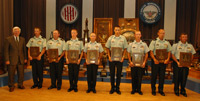
|
|
USAMU Hopper easily won the 2007 Infantry Trophy Match. Team coach was SFC Lance Hopper. Team captain was SFC Lance Dement. Team firing members were SFC Kyle Ward, SFC Grant Singley, SSG Emil Praslick, SGT Brandon Green, SPC Elliot Farro and SPC Tyrel Cooper.
|
USAMU Hopper won this year’s Infantry Trophy Match and the Infantry Trophy by a 119 point, 1330 to 1211 margin over USAR Gold. The USAR Gold team won the Celtic Chieftain Trophy as the high Reserve Component team. Pennsylvania finished third overall with a 1158 total to take the Leatherneck Trophy that is awarded to the high Civilian team. The Washington State R&PA “Bad Apples” junior team was fifth overall and won the Junior Infantry Trophy as the top Junior team.
Complete results for the team matches are posted on the CMP web site http://clubs.odcmp.com/cgi-bin/report_matchResult.cgi?matchID=2113. To view a complete collection of photos of the National Trophy Team Matches winners as well as of dozens of other competitors in the match, go to http://www.odcmp.com/Photos/07/NTI/index.htm. These impressive photos were taken by Web Wright, a professional photographer who is also a Triple Distinguished Shooter.
NEXT ARTICLE |
|
|

